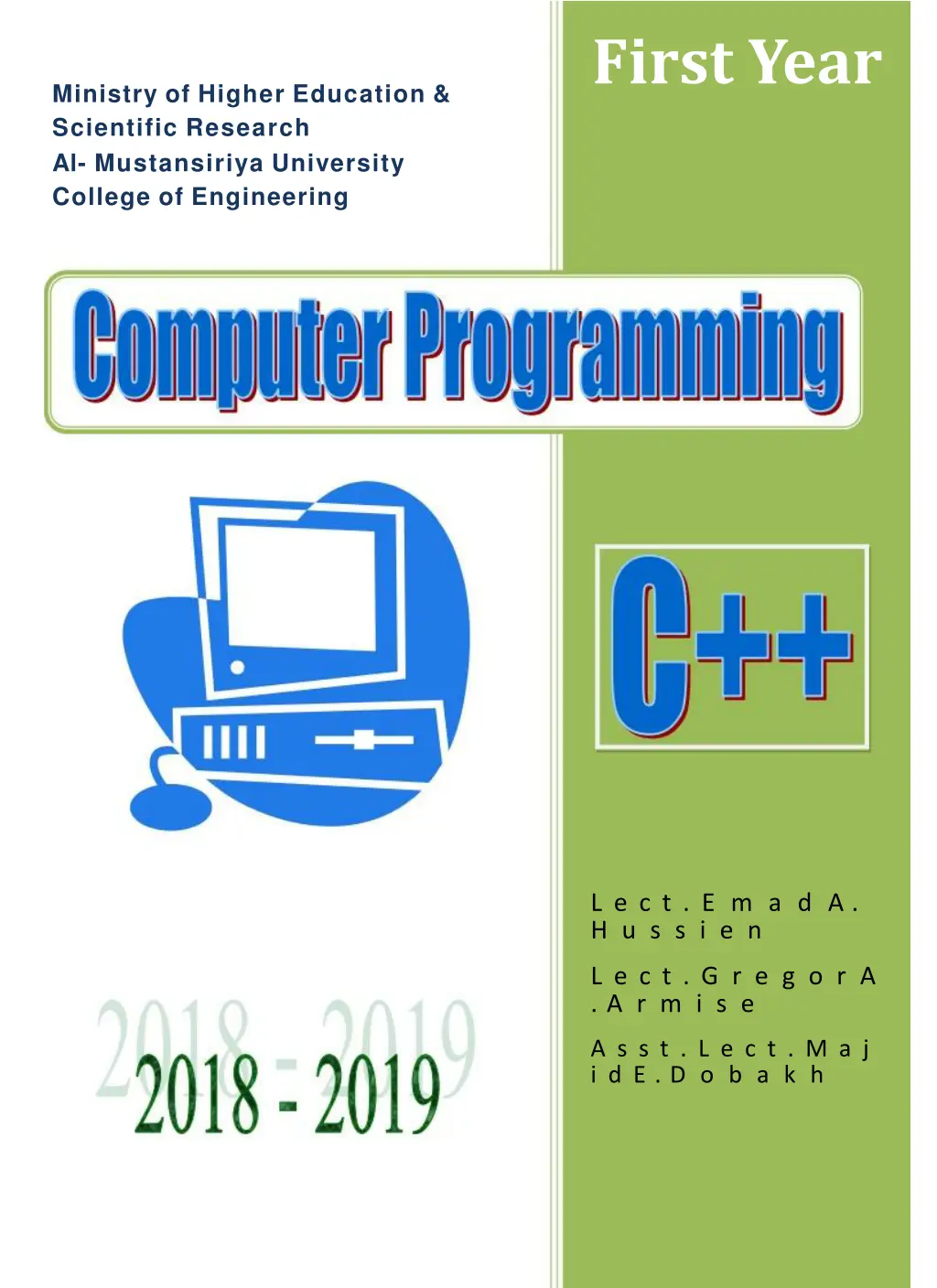
Order Evaluation in C++ Programming and Math.h Library Functions
Explore examples of order evaluation in C++ programming, including writing equations as C++ expressions and understanding binary operators. Learn about common mathematical functions from the Math.h library and their usage in scientific equations. Dive into manipulating variables with prefix and postfix notations, and discover the usage of special stream functions like Endl and Setbase in C++ programming.
Download Presentation

Please find below an Image/Link to download the presentation.
The content on the website is provided AS IS for your information and personal use only. It may not be sold, licensed, or shared on other websites without obtaining consent from the author. If you encounter any issues during the download, it is possible that the publisher has removed the file from their server.
You are allowed to download the files provided on this website for personal or commercial use, subject to the condition that they are used lawfully. All files are the property of their respective owners.
The content on the website is provided AS IS for your information and personal use only. It may not be sold, licensed, or shared on other websites without obtaining consent from the author.
E N D
Presentation Transcript
First Year Ministry of Higher Education & Scientific Research Al- Mustansiriya University College of Engineering L e c t . E m a d A . H u s s i e n L e c t . G r e g o r A . A r m i s e A s s t . L e c t . M a j i d E . D o b a k h
Lecture 5 1 Examples of order evaluation: 1 Examples of order evaluation: Example 1: Write the following equation as a C++ expression: Solution: f = (a + b + c + d + e) / 10; Note: the parentheses here are required because division has higher precedence than addition. Example 2: State the order of evaluation for the following expression: Z = P * R % Q + W / X Y; Solution: 1. * 2. % 3. / 4. + 5. - Example 1 Write C++ program to perform the above equation: #include<iostream.h> void main( ) { int Z, P, R, Q, W, X, Y; cout << "enter P:"; cin >> P; cout << "enter R:"; cin >> R; cout << "enter Q:"; cin >> Q; cout << "enter W:"; cin >> W; cout << "enter X:"; cin >> X; cout << "enter Y:"; cin >> Y; Z= P * R % Q + W / X - Y; cout << "the result="<< Z;
2 The math.h Library: 2 The math.h Library: The math.h library contains the common mathematical function used in the scientific equations. Common function from math.h library: Mathematical Expression C++ Expression e Log(x) Ln(x) Sin(x) x x Exp(x) Log10(x) Log(x) Sin(x) Pow(x,n) Sqrt(x) Example: Write the following equation as a C++ expression and state the order of evaluation of the binary operators: Solution: f = sqrt ((sin(x) pow(x,5)) / (log(x) + x/4)) Order of evaluation: Exercise: Write the following equation as a C++ expression and state the order of evaluation of the binary operators: Solution:?
The ++ and - - operators can be written either before the variable (prefix notation) or after the variable (postfix notation) as in the following: Prefix notation: ++ X X is incremented before its value is taken or returned to current statement. X is incremented after its value is taken or returned to current statement. Postfix notation: X ++ The difference between the Prefix and Postfix notations: Prefix notation int y; int x = 7; cout<< ++x <<endl; y=x; cout<<y; Postfix notation int y; int x = 7; cout<< x++ <<endl; y=x; cout<<y; Output: 8 8 3 Manipulator Functions: 3 Manipulator Functions: They are special stream functions that change certain characteristics of the input and output. (a) Endl: Generate a carriage return or line feed character. Cout << a << endl; (b)Setbase: It is used to convert the base of one numeric value into a nother base Dec(base 10), hex(base 16), oct(base 8) Output: 7 8 Example 2 Write C++ program to convert a base of a number: #include<iostream.h> void main( ) { int value; cout << "enter number:"; cin >> value; cout << "Decimal base= <<dec<<value<<endl; cout << "Hexadecimal base= <<hex<<value<<endl; cout << "Octa base= <<oct<<value<<endl; Enter number 10 Decimal base=10 Hexadecimal base=a Octal base=12 } When using setbase the statement will be:
Cout<<Decimal base=<<setbase(10); Cout<<value<<endl; (c) Setw: It is used to specify the minimum number of character positions on the O/P field a variable will consume: setw(int w) Example 3 Write C++ program to use tab: #include<iostream.h> #include<iomanip.h> void main( void) { int a,b; a=200; b=300; cout<<a<< \t <<b<<endl; } 300 200 Example 4 Write C++ program to use setw: #include<iostream.h> void main( void) { int a,b; a=200; b=300; cout<<setw(5)<<a<<setw(5)<<b<<endl; cout<<setw(6)<<a<<setw(6)<<b<<endl; #include<iomanip.h> 200 200 300 300 } (d)Setfill: It is used to specify a different character to fill the unused field width of the value. Setfill(char f)
Example 5 Write C++ program to use setfill: #include<iostream.h> #include<iomanip.h> void main( void) { int a,b; a=200; b=300; setfill( * ); cout<<setw(5)<<a<<setw(5)<<b<<endl; cout<<setw(6)<<a<<setw(6)<<b<<endl; **200**300 ***200***300 } (e)Setfill: It is used to control the number of digits of an output stream display of a floating point value. Setprecision (int p) Example 6 Write C++ program to use setprecision: #include<iostream.h> #include<iomanip.h> void main( void) { float a,b,c; a=5; b=3; c=a/b; setfill( * ); cout<<setprecision(1)<<c<< endl; cout<<setprecision(5)<<c<< endl; 1.7 1.66667 }
WORK SHEET (2) (1) First Elements of C++ Q1: What do you means by C++ character set? Q2: What do you means by identifiers? What is the maximum length of identifiers? Q3: What do you means by case-sensitive? Q4: What do you means by reserved word? Q5: Write a general layout of C++ program. Comment on each part of it. Q6: What is the main purpose of endl and \n ? Q7: List and comments on the special escape codes. Q8: What are the main types of variables, its sizes, and its range of values? Q9: What do you means by constants? Q10: List the priorities of the arithmetic operations. Q11: Find the value of A for the following: A = (5 + 2 * 3 + (( 3 2 ) * 7) + -9 ) / 2. Q12: What are the main keywords are includes in iostream.h and math.h? Q13: What are the main difference between prefix and postfix notation? Q14: Find the value of B (true or false) for the following: i= 5; j = 9;
B= ! (( i > 0 ) && ( i >= j )); Q15: Write C++ program to read x and compute sin, cos, and tan of x. Q16: Rewrite the equivalent statements for the following examples, and find it results. Assume: X=2 , Y=3 , Z=4 , V=12 , C=8. (X+=5 , Y-=8, Z*=5 , V/=4 , C %=3) Q17: Given that A and B are real variables with values 1.5, and 2.5 respectively, and C is integer variable with value 3, evaluate the following: NOT (A < 0) AND (B/C <= 0). Q18: Write a program in C++ to find the area of a circle. Q19: Write a program to read a set of (5) real no.s and find out the sum and average of them.






















